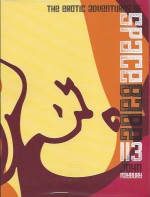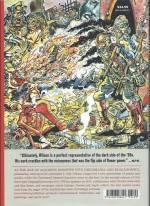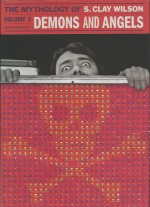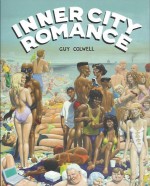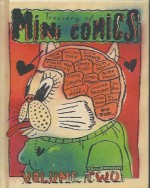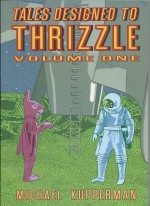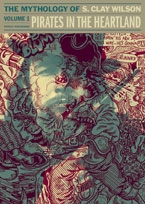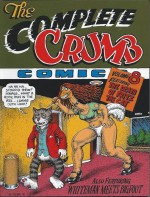
By Barbara Canepa & Alessandro Barbucci (Titan Comics)
ISBN: 978-1-78276-736-7
Astoundingly barbed political and anti-consumerist satirical allegory Skydoll has been appearing sporadically since 2000. It’s the other work of frequent collaborators Alessandro Barbucci and Barbara Canepa (whose usual offerings include more family-oriented fare such as W.I.T.C.H. and Monster Allergy) and – although rendered in the subtly seductive anthropomorphic style developed and signifying decades of wholesome Disney cartooning – is a superbly strident attack on corporate consumerism, the media’s mesmerism of the masses, political expediency, religion and the power of the Catholic church, all wrapped up in the raunchy, beguiling trappings of super-sexy science fiction shenanigans…
Now most of the components thus far generated have been beautifully bound up in a gloriously oversized (284 x 212mm) full-colour hardback edition.
The subversive odyssey begins with the prose ‘Preface: ten years of Skydoll’: a bold declaration of intent by The Authors before we speed straight into the fantastic fantasy with ‘Volume 1: The Yellow City’ which introduces fetching, wind-up automaton Noa, asking God for a little fair treatment whilst working at the insalubrious Heaven Spaceshipwash. She’s not like the other beautiful dolls working there. Although she still needs to be wound-up every 33 hours by her owner, this alluring automaton seems to have a memory that doesn’t erase itself after a couple of days. This means she keeps thinking of difficult fresh questions to ask…
Furiously shoved back to work, Noa ignores the fabulously bland and vapid blatherings of TV talk show monolith Frida Decibel blasting out from every home and public broadcast screen, telling the populace of Papathea how good everything is now that they only have one Popessa in the buxom form of the divine Ludovica.
Once upon a time there were two True Vicars of God: Agape who embodied spiritual love and Ludovica who personified its physical expression. When Agape mysteriously vanished her corporeal partner became sole arbiter of the galactic empire the church controls, commencing a campaign of craftily concocted public miracles to pacify the increasingly irate and disillusioned populace.
It’s not really working though, and a rising tide of rebellion and resentment is just beginning to pop…
Our story really begins when two of Ludovica’s “Diplomatic Agents†stop at Heaven to get their starcraft properly shined before heading out on their top-secret mission. Old Jahu is especially keen on the diversion: everybody knows lusting after or even indulging in pleasure with a Doll doesn’t count as sin. The Popessa said so…
However, whilst lathering up the ship of some fervent fundamentalists at the head of the queue, Noa accidentally kicks off a small riot, even as across the city Ludovica’s latest manufactured miracle kicks into high-gear with mesmerising effect…
By the time the barrage of supernal glitz and gaudy glitter subsides, Jahu and young idealistic Roy are well on their way. They have no idea there’s a dazed and surprised stowaway aboard, with her crucial, life-sustaining key still negligently left in her back…
And on the rapidly dwindling planet behind them, Ludovica fumes. Despite getting rid of her rival, the sole Popessa’s grasp of power is still uncertain. The people still hunger for vanished Agape and there are rumours of rebellion. The anxious, power-mad pontiff has no idea how close to home the sedition reaches…
Aboard ship Roy has made a startling discovery. Unable to help himself, he turns the key in the inert innocent’s back and restores temporary autonomy to a vivacious creature he can’t help but like…
Doctrinaire Jahu is less sanguine but the mission is too important to delay. They can always dump the doll on the way home…
Noa is eternally curious, asking questions about everything. She is inexplicably especially moved by an illicit image of Agape the voyagers encounter in a space restaurant. It somehow triggers strange and terrifying visions and Roy has to physically restrain Noa. What happens next is regarded by the astounded onlookers as a miracle…
The story resumes with ‘Volume 2: Aqua’ as hints begin about Noa’s destiny and the unseen sponsors who seem to be guiding her destiny. The Popessa’s missionary ambassadors meanwhile land on the world without males: one successfully propounding a third spiritual way…
Governed by planetary Guru Gaia, the women of Aqua are steadily gaining support across the universe, supported and funded by their range of wellness centres and luxury goods which everyone wants to try. Roy is there to build diplomatic bridges between the Popessa and the completely antithetical Aquans in the cause of peace. He has no idea that Jahu’s orders are a little different. He always knew the only way to deal with heretics…
Noa inveigles her way into the official conference: she’s hopeful these strange women will have some insight into her own rapidly-expanding consciousness. She is stunned by what they do know and their connection to missing Agape.
And as Jahu goes about his bloody work, back on Papathea, bloody revolution breaks out…
The intrigue expands in ‘Volume 3: The White City’ when Roy, Jahu and the constantly-growing Noa return as triumphant heroes. When officially interviewed by the ubiquitous Frida Decibel the web of intrigue and damnation expands to encompass some very unexpected personalities, even as the empire stands poised on the edge of Armageddon and real miracles start happening in the most unlikely places…
A broad, vast, clever and frustrating unfinished epic, Skydoll is still unfolding at its own tantalising pace. There has however been plenty of sidebar and ancillary material released such as ‘Volume 0: Doll’s Factory’ which offers a sequence of prequel events to flesh out the main characters in another stunningly captivating art package.
Here a strange woman visits a factory and places something miraculous inside a doll in its final stages of manufacture, whilst ‘Heaven’s Dolls’ rewards the reader with information on the world and empire of the Popessa, affording insights into other Dolls such as Lovely Lou, Juicy Lee, Sandy Blue and God himself – proving just why he needed killing…
There’s also a hilarious Sky Doll ‘Psycho-grapho Test’ to further reveal how life and society really work…
This immaculate confection culminates in a huge collection of ‘Homages’: a breathtaking gallery of tribute images of Sky Doll and her chums by a staggeringly talented cast of fellow artists comprising Claire Wendling, Karla Diaz, Benjamin, Marguerite Sauvage, Mijin Shatje, Cyrille Bertin, Tony Infante, Bengal, Claudio Acciari, Tony Sandoval, Amélie Fléchais, Giovanni Rigano, Sefora Pons, Gradimir Smudja, Aurore, Augustin Rolland, Nenent, Guezav, Pierre-Mony Chan, Lucy Mazel, Véronique Meignaud, Matteo De Longis, Xavier Collette, Anne Cresci, Lilidoll, Jérémie Almanza, Lostfish and more.
Completing and concluding religious experience is a comprehensive feature ‘About the Authors’ and a page packed with ‘Acknowledgements & Credits’.
A phenomenal work-in-progress, Sky Doll is a superbly engaging exploration of erotica, iconology and idolatry: one no fun-loving, deep-thinking lover of comic iconoclasm should miss.
Sky Doll and all contents are © Editions Soleil/Barbucci/Canepa. This translated edition © 2016 Titan Comics.
Sky Doll: Decade will be in UK store from March 15th 2016.

